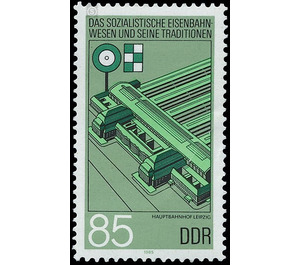Railway Engineering - Germany / German Democratic Republic 1985 - 85 Pfennig
Theme: Architecture
| Country | Germany / German Democratic Republic |
| Issue Date | 1985 |
| Face Value | 85.00 |
| Color | green |
| Perforation | K 12 1/2: 13 |
| Printing Type | offset |
| Stamp Type | Postage stamp |
| Item Type | Stamp |
| Chronological Issue Number | 2713 |
| Chronological Chapter | GER-DDR |
| SID | 383894 |
| In 18 Wishlists | |
The socialist railway system and its traditions With images from the railway industry, the Ministry of Posts and Telecommunications of the German Democratic Republic issued four multicolored special postage stamps. Special cancellations from September 24 to November 23, 1985 Socialist railways and their traditions The railways, which developed in the first half of the nineteenth century, have become, in the course of their historical development, a means of transporting medium and heavy traffic flows, even over large ones Distances developed in both freight and passenger transport. The German Democratic Republic has a well-developed railway network with a total length of more than 14,200 km, of which more than 2,000 km of railway lines are electrified. It has a network density of over 13 km per 100 square kilometers of territorial area. Around 8,000 freight trains and more than 7,000 passenger trains run daily. In total, around one million tonnes of goods and two million people are transported daily on average. The primary goal of socialist transport policy was and is to realize the ever-growing economic and social demands for changes in the location of goods and people with the least economic effort. In the realization of these objectives, the railway takes a special place. The electrification of the railway lines is currently the most important rationalization measure to secure the increase in capacity of the railway and serves the economically necessary reduction of transport and energy costs. The electric locomotives have a greater Anfahrzugkraft and a higher acceleration capability and are much more environmentally friendly. The passability of the electrified lines increases by eight to twelve percent and the economics of operations management is significantly improved. For the effective construction of the overhead line of the electric network, helicopters of the type Mi-8 originating from Soviet production are used. This makes it possible to increase the productivity compared to the conventional technologies when placing the catenary masts on the tenfold and in the catenary assembly on six times. To increase safety, the Deutsche Reichsbahn continues the modernization of the lines and stations with modern security and telecommunications technology by the further development of Gleisbildstellwerken. The development of the material-technical basis of the railway is closely linked to the great commitment of the approximately 250,000 railway workers. The 40th anniversary of the railway of the GDR in the hands of the people and the 150th anniversary of the German railroad are occasion to appreciate the technology of the railway from the present and history and the achievements of the railroaders in the form of a special postage stamp issue. 85 Pfennig value: Hauptbahnhof Leipzig Important traffic junction for the travelers and visitors at home and abroad of the more than 800 years old trade fair metropolis and one of the largest passenger stations in Europe. Although almost 70 years old, the façade of the reception building continues to impress because of its monumental beauty. Every day about 250 trains arrive and depart from the 26 platform tracks. 150,000 travelers, during the fair daily over 200,000, are to be handled. Departure signals for trains as a command staff (signal of supervision) and as a checkered signal flag (signal of the train driver).


